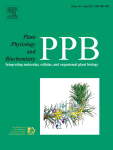Ver ítem
- xmlui.general.dspace_homeCentros Regionales y EEAsCentro Regional Entre RíosEEA ConcordiaArtículos científicosxmlui.ArtifactBrowser.ItemViewer.trail
- Inicio
- Centros Regionales y EEAs
- Centro Regional Entre Ríos
- EEA Concordia
- Artículos científicos
- Ver ítem
“Harder, better, faster, stronger: Frost tolerance of Eucalyptus benthamii under cold acclimation"
Resumen
Eucalypts are the most planted hardwood trees worldwide because of their very rapid growth, exceptional wood quality and adaptability. However, most commercial species and derived hybrids are sensitive to frost, which remains as the largest obstacle to their introduction in warm/temperate climates. As evergreen species, Eucalypts have developed the ability to tolerate frost events based on physiological and molecular responses triggered by previous
[ver mas...]
Eucalypts are the most planted hardwood trees worldwide because of their very rapid growth, exceptional wood quality and adaptability. However, most commercial species and derived hybrids are sensitive to frost, which remains as the largest obstacle to their introduction in warm/temperate climates. As evergreen species, Eucalypts have developed the ability to tolerate frost events based on physiological and molecular responses triggered by previous exposure to cold temperatures, globally named cold acclimation. To characterize the acclimation process in two species with different tolerance to frost, E. grandis (Eg) and E. benthamii (Eb), seedlings were exposed for different times to low temperatures. Frost tolerance was estimated in leaves by an electrolyte leakage assay, and metabolome and morpho-physiological changes studied and correlated to the observed acclimation responses. Eb showed higher basal frost tolerance and an earlier and stronger acclimation response to cold temperatures than in the frost sensitive Eg. Eb was able to modify several morpho-physiological parameters, with a restriction in plant height, leaf area and leaf fresh weight during acclimation. Metabolome characterization allowed us to differentiate species and strengthen our understanding of their acclimation response dynamics. Interestingly, Eb displayed an early phase of sugar accumulation followed by a rise of different metabolites with possible roles as osmolytes and antioxidants, that correlated to frost tolerance and may explain Eb higher capacity to acclimate. This novel approach has helped us to point to the main metabolic processes underlying the cold tolerance acquisition process in two relevant Eucalyptus species.
[Cerrar]

Autor
Oberschelp, Gustavo Pedro Javier;
Morales, Luisina Lourdes;
Montecchiarini, Marina Lucia;
Harrand, Leonel;
Podestá, Florencio Esteban;
Margarit, Ezequiel;
Fuente
Plant Physiology and Biochemistry (Available online 28 June 2022)
Fecha
2022-06
Editorial
Elsevier
ISSN
0981-9428
1873-2690
1873-2690
Documentos Relacionados
Formato
pdf
Tipo de documento
artículo
Proyectos
(ver más)
INTA/2019-PE-E6-I146-001/2019-PE-E6-I146-001/AR./Mejoramiento genético de especies forestales cultivadas de rápido crecimiento: un desarrollo clave para el fortalecimiento de la foresto industria nacional.
Palabras Claves
Derechos de acceso
Embargado
 Excepto donde se diga explicitamente, este item se publica bajo la siguiente descripción: Creative Commons Attribution-NonCommercial-ShareAlike 2.5 Unported (CC BY-NC-SA 2.5)
Excepto donde se diga explicitamente, este item se publica bajo la siguiente descripción: Creative Commons Attribution-NonCommercial-ShareAlike 2.5 Unported (CC BY-NC-SA 2.5)

